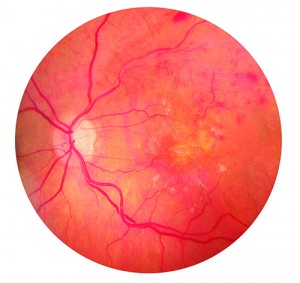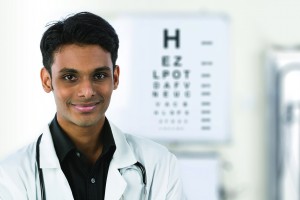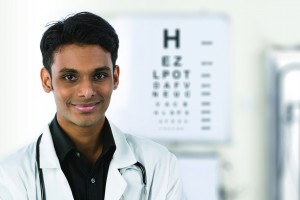 The retina is the nerve tissue in the back of the eye that requires healthy blood circulation for visual function. When blood vessels to the retina are blocked, it is known as a retinal vein occlusion or “eye stroke” and can cause sudden blindness.
The retina is the nerve tissue in the back of the eye that requires healthy blood circulation for visual function. When blood vessels to the retina are blocked, it is known as a retinal vein occlusion or “eye stroke” and can cause sudden blindness.
There are two types of retinal vein occlusions: Central Retinal Vein Occlusion (CRVO) and Branch Retinal Vein Occlusion (BRVO).
About
CRVO
Blood enters the retina through the central retinal artery and drains out of the retina through the central retinal vein. When the central retinal vein becomes blocked, this is called a central retinal vein occlusion or CRVO. This means that blood cannot flow in and out of the retina properly, causing the retina to fill up with blood and swell, resulting in vision loss.
There are two types of CRVO:
- Non-ischemic CRVO. This is less serious and accounts for a majority of the cases.
- Ischemic CRVO. This is the more serious form because the retina becomes so “starved” for oxygen that new blood vessels grow in various locations in the eye to improve the insufficient blood supply. Unfortunately, this is dangerous and can lead to vision loss and possibly loss of the eye.
BRVO
This is when the small branches of the main vein in the retina are blocked. As with CRVO, part of the retinal blood flow slows down or stops which results in vision loss. This usually occurs in one eye and results in blurred vision or a missing area of vision.
Symptoms
- Sudden loss of vision or blurring in part or all of one eye
- Floaters (small moving spots) in your vision in severe cases
- Painful pressure in the eye
Prevention
As in other health issues a healthy diet and lifestyle help stave off Retinal Vein Occlusion. In addition, to that maintaining diabetes is also helpful.
Diagnosis
Diagnosing eye conditions requires eye exams, which include the specialist looking for fluid or blood in the back of the eye after performing dilation and also testing for defects in central vision.
Questions to Ask Your Health Care Provider
- Is there any chance that my vision will improve?
- Are there treatments are available for my condition?
- What type of tests will my eye specialist perform?
- Will this disease spread to my other eye?
- Will I lose my vision?
- How will my lifestyle change after diagnosis?
- What lifestyle changes do I need to make to delay progression of the disease?
Treatments
Unfortunately there is no way to unblock retinal veins. However it may be possible to prevent another blockage from forming in the same or the other eye. This can be done through laser treatment, drug injections or a vitrectomy (surgery). Many people may regain some of the lost vision without treatment, however, their vision rarely returns to normal.


